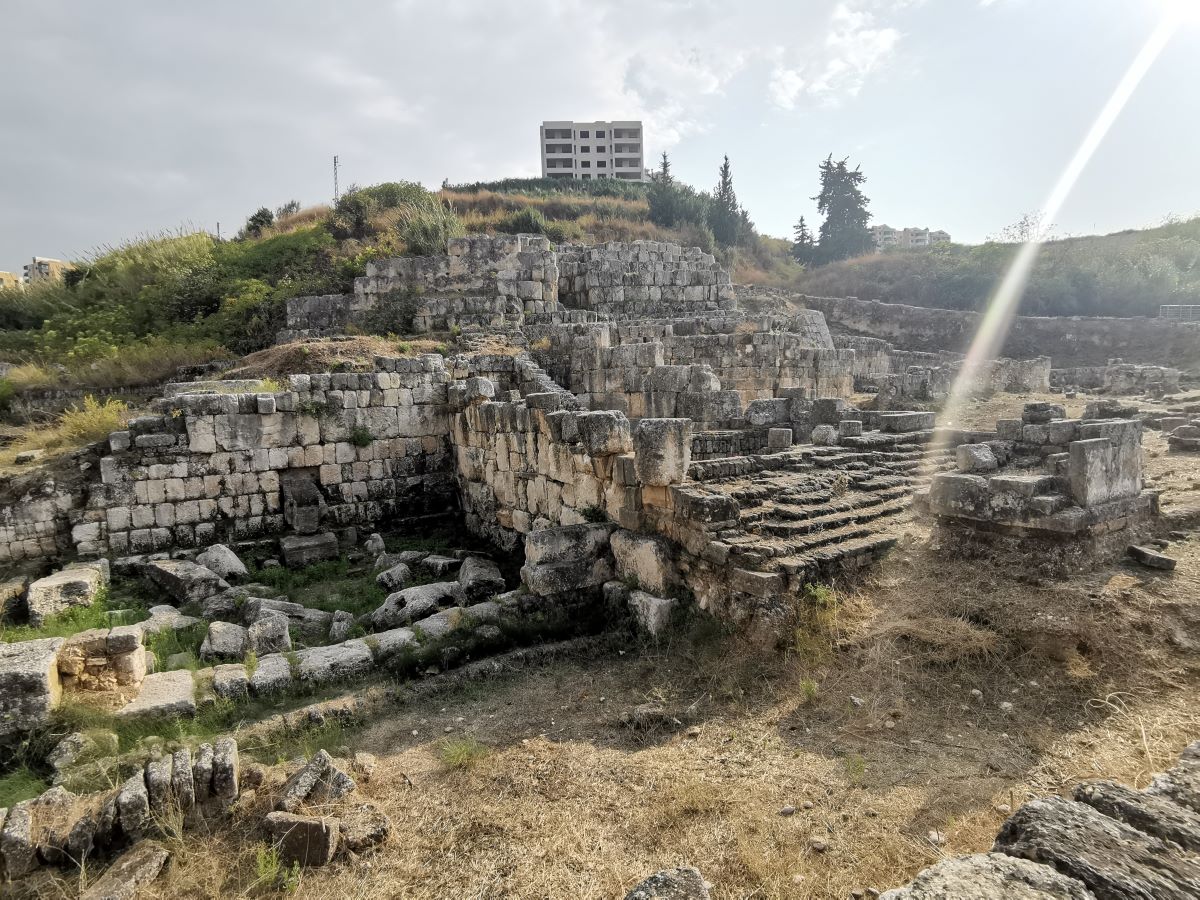The holy site of Eshmun holds the largest and best preserved Phoenician temple in Lebanon known to date. It was famous for over 1000 years for its healing cult and religious practices.
This article presents a brief description of the site history through its archeological findings.
Deity
Eshmun was the Phoenician god of healing and fertility; and the main male divinity worshiped by the Sidonians.
Legend has it that Eshmun, a young man from Beirut, was hunting in the woods when Astarte, goddess of war and sexual love, saw him and was stricken by his beauty. She harassed him with her amorous pursuit until he emasculated himself with an axe and died. The grieving goddess revived Eshmun, making her his consort.
Eshmun was identified to Asklepios, the Greek god of medical art. It is from belief in the healing power of Eshmun-Asklepios and the snake that we get the sign of the medical profession that is now used worldwide.
Our modern caduceus, a staff entwined with 2 serpents, is derived from these symbols. A couple of coins depicting the god Eshmun holding a staff entwined with 2 serpents were found in Beirut and at Eshumn site.
Location
The site is located north – east of Saida, overlooking the Awali river, in an area known as Bustan El Cheikh.
Like many other Phoenician temples built around Lebanon, Eshmun temple was founded at the proximity of the Awali river – the water being the main source needed for the religious practices.
Discovery
The site of Eshmun was uncovered by the mid 19th century AD thanks to the sarcophagus of Eshmunazar II (Phoenician king of Sidon, 6th Century BC), unearthed near Sidon, and that bears a Phoenician inscription stating that Eshmounzar II with his mother Amashtart “built a temple for our prince saint Eshmun at the Yidll source in the mountain” – Yidll being the water source near the Asclepius river (modern Awali).
Other Phoenician inscriptions scattered around Saida have also helped in locating the site.
Timeline
The site underwent several construction projects and modification by successive civilizations.
6th century BC – Foundation of the 1st podium that held the temple structure during the Neo-Babylonian period.
6th century – 5th century BC – Foundation of the 2nd and larger podium that held the temple structure during the Persian era.
4th century BC – The temple site gets heavily damaged following an earthquake.
3rd century BC – A new temple is added on site, and several modifications took its toll on and around the initial edifice, which would bear Greek, Assyrian and Persian architectural influences.
3rd century AD – A colonnaded street is added at the temple site, a nympheum and villa during the Roman era.
4th century AD – The temple structures vanish and the cult of Eshmun ends during the Byzantine era, and a church is built on site.
551 AD – The 551 AD earthquake damaged heavily the site which fell in despair for the coming centuries.
17th century AD – Fakrh El Dine II uses the massive podium stones to construct a bridge over the Awali river.
19th century – 20th century AD – discovery of the site by archeologists and regular treatment is performed on the structures and mosaics.
Archeological site
The archeological site of Eshmun houses the remains of several religious edifices, and remnants of other structures:
The 1st Temple Podium – A pyramid-shaped structure of the 1st podium (6th century BC) with a short flight of stairs on its summit and a wall to its right can still be seen on site.
The 2nd Temple Podium – The 2nd podium built during the Persian era is the main massive section of the site.
The 2 shrines – Located at the left bottom side of the podium, of cubic shape. The shrines held 2 bull adornment that date back to the Persian era. The adornments are now exhibited at the National Museum of Beirut.
The Hellenistic Temple – the 3rd century BC temple is located on the bottom right side of the temple. The frieze of the temple bears bas-relief of worshippers, hunting scenes and children’s games.
The Throne of Astarte – The so-called “Throne of Astarte” is located on the right side of the Hellenistic temple. The Throne stands on a single block of stone with a cornice sculptured in the Egyptian style. The frieze above the throne depicts a hunting scene.
The Roman Nympheum and colonnaded street – during the roman era, the temple of Eshmun and its miraculous waters continued to serve as a place of pilgrimage. The Romans added the processional walkway, basins for ablutions and a nympheum that are still visible to date. The columns of the walkway would be later taken by the crusaders to use it for building their sea castle near the port of Saida.
The 4 season mosaic – on the left side of the colonnaded street, one can see the remains of a mosaic that depicts the 4 seasons. It is one of the rare colored and large mosaics found in Lebanon.
The Byzantine church – to the left of the colonnaded street, one can see the remnants of a Byzantine church, which is the last structure built at Eshmun site.
Around the archeological site – remnants of residential structures can be seen around, on the eastern side of the holy edifice. Additional findings such the famous “Eshmun Tribune”, inscription tablets and statutes of children were found during excavations and are exhibited at the National Museum of Beirut.
Karim Sokhn
Tour Operator & Tour Guide
References:
BAAL, Volume 4, 2000
Ministry of Tourism, Echmoun Brochure










